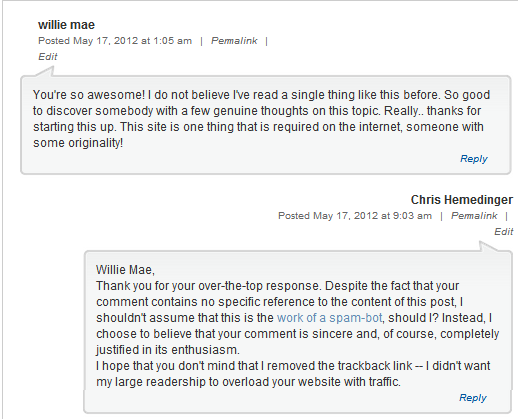This is the cross-post of a funny and informative post written for an internal SAS blog by my colleague and blogger extraordinare Chris Hemedinger. For those of you not familiar with "spam," it's a scourge of electronic media that shows up in blog comments among other places - placed with the intention of gaining better search exposure for the originator of the message.
Chris' post outlines how you can recognize spam comments when you see them:
-----------
I've noticed an uptick in the number of spam comments that arrive daily for my external SAS blog. Fortunately, we moderate our comments so that most spammy comments never see the light of day on blogs.sas.com, except for the occasional ego-boosting example that I might allow to go through:
The purpose of the spam comments, as far as I know, is to dupe blog authors into accepting content that contains a URL link back to the spam sponsor, thus increasing the search rank relevance of the sponsor's web site and increasing visitor traffic. I suppose that their increased traffic can be monetized in some way, and that is why they go through this effort (or more likely, they have some sort of spam-bot that does the work for them). Our blogs draw a lot of traffic, and I guess this is the price we pay for popularity.
As a public service to our bloggers, I've dissected one example of a spam comment and labeled it here. Note that we receive lots of legitimate comments every day as well, and their anatomy is only slightly different...which is why each comment requires a close inspection.
In 2012 our [SAS] blogs have received over 2500 legitimate comments. I regard this as an important measure of engagement among our readers, perhaps at least as telling as the number of tweets, Facebook "likes", and simple raw visitor traffic.
-----------
Thank you for that excellent post, Chris!
The shameless flattery aspect of so many of these spam comments is what gives me a chuckle. Here is a listing of some of my favorites. I encourage all my excellent and illustrious followers to shower me with this kind of flattery often:
- Wonderful work! That is the type of information that should be shared around the internet. Shame on Google for not positioning this submit higher!
- I'll immediately clutch your rss feed as I can not find your email subscription link or newsletter service. Do you've any? Kindly allow me realize in order that I may subscribe.
- I've been surfing online more than 4 hours today, yet I never found any interesting article like yours. It is pretty worth enough for me. Personally, if all webmasters and bloggers made good content as you did, the internet will be a lot more useful than ever before.
- Greetings from Carolina! I'm bored to tears at work so I decided to browse your website on my iphone during lunch break.



3 Comments
Hi John,
The sneakiest spam attempt I've ever seen on my own blog was a comment just a few weeks ago that was very context specific. The enterprising spammer must have thought they might be able to get through the combined machine & human spam filters by posting something that appeared to be more relevant to the target blog. Being a SAS software related blog they had gone to the trouble of pasting the bio of a well known SAS Institute person as the comment text. It looked like they'd extracted it from a SAS Global Forum paper! It did make me pause for a moment, but when I saw the associated trackback link that it was clear it was a spam attempt so despite their initiative it still didn't make it through.
Cheers
Paul
Hi Paul,
Thanks for sharing your example. I think bloggers are just going to have to continue to be vigilant with those comments because spammers are constantly evolving. Perhaps some clever entrepreneur can develop a product like "Spam-off,
where spam comments magically disappear with a click of a mouse. Until then, we'll just have to continue the manual way...
Cheers!
JB
Pingback: The importance of measuring your business pain - The SAS Dummy